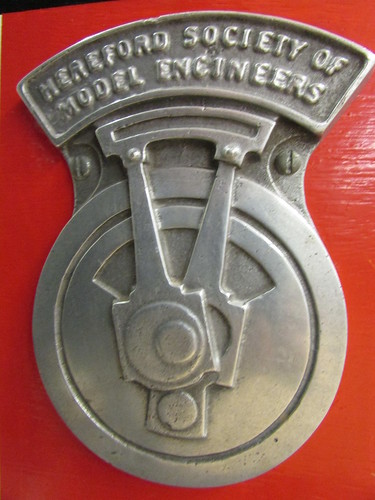
The 'shield' of the Hereford Society of Model Engineers.
Getting there
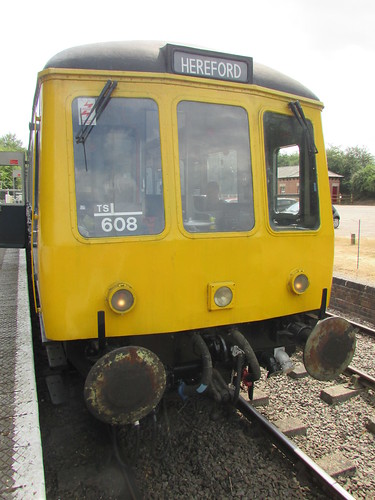
"Boarding the train to Hereford". Picture posed at Shenton on 28th July 2018.
To Hereford by train? I'm afraid it's been some years since it was possible to get to Hereford using the type of 1950s Diesel Multiple Unit shown above. However, I was rostered to drive a preserved DMU at the Battlefield Line a couple of days before 'Lionsmeet' and knowing that Hereford was one of the destinations served by Tyseley depot, the unit's last allocation before withdrawal, I couldn't resist posing this shot.
I actually travelled to Hereford in a modern Class 172 and that journey is described in the post To Hereford by rail. A taxi then took me across the city to the event. My return rail journey, via Shrewsbury, is described here.
The Event
In the summer of 2018 Britain experienced a period of unbroken hot weather extending for a number of weeks but on the journey to Hereford I'd encountered areas of heavy rain. Although it was dry on my arrival at Broomy Hill, the skies darkened and live-steam running of models was eventually curtailed by rain which started gently but later had a monsoon nature.
Our hosts, the Hereford Society of Model Engineers (HSME) are a long-established club who moved to the spacious Broomy Hill site in the 1960s, I believe. A mature and well-equipped site now greets visitors. The site is adjacent to the historic Waterworks Museum which was operating the following day (and steaming their stationary pumping engine) but, sadly, was closed on the day of 'Lionsmeet'.
At HMSE, there are elevated and ground level running tracks, together with a 20m x 30m model boating pond all laid out on a plain. The club house, workshops and an extended garden railway are situated on somewhat higher ground.
Elevated Track
I started my visit at the continuous elevated track which serves 3.5 inch and 5 in gauge models and was greeted by Lionsmeet co-ordinator Andrew Neish. I found a well-equipped station, Compton High Level, with an overall roof adjacent to raised steaming bays radiating from a turntable which were also provided with roofing. Three 'Lion' models were being prepared but early-bird Adrian Banks was already out on the running track.
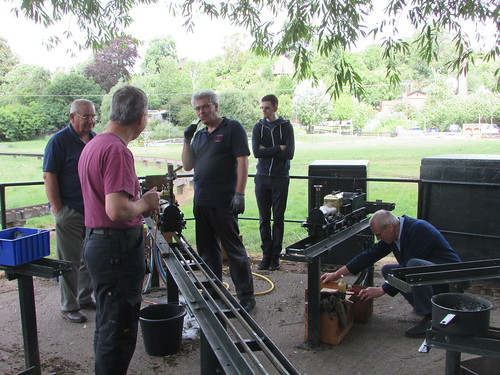
'Lionsmeet' 2018 28th July 2018: The covered steaming bays serving the elevated track radiate from a turntable.
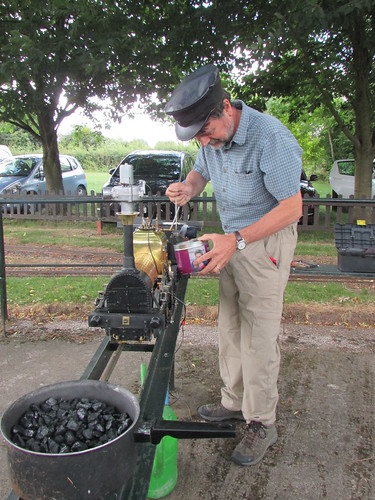
'Lionsmeet' 2018 28th July 2018: A new member of OLCO preparing his model.
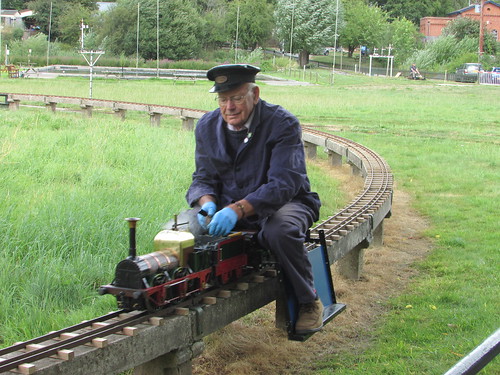
Lionsmeet' 2018: Adrian Banks was in steam early with his 'Thunderbolt' model. In the background, the model boat pool and John Dalton on the ground level track (having just passed under the 3-doll signal gantry). The brick building on the right is part of the adjacent Waterworks Museum.
A little later, after Adrian had finished his running, the other 'Lion' models shared the elevated track until deteriorating weather eventually drove everybody up to the clubhouse where for lunch and conversation.

'Lionsmeet' 2018 28th July 2018: Three 'Lion' models on the elevated track at HMES.
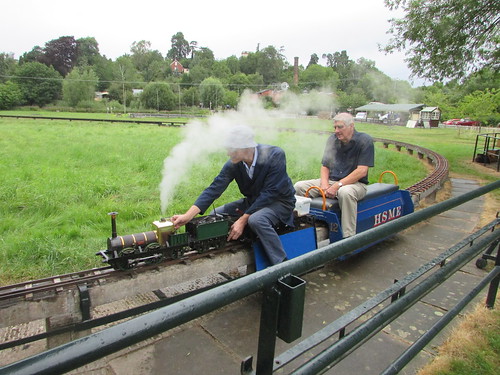
'Lionsmeet' 2018 28th July 2018: Jon Swindlehurst and his 5-inch 'Lion' with OLCO Chairman John Brandrick as passenger.
Ground Level Track
The main station on the extensive dual-gauge (5 inch and 7.25 inch) ground level track is Broomy Hill Junction, provided with an island platform with canopy, ticket office and signal box. A turnout here leads to a turntable serving a number of ground level sidings plus an incline leading to a sector table with six elevated preparation roads radiating.
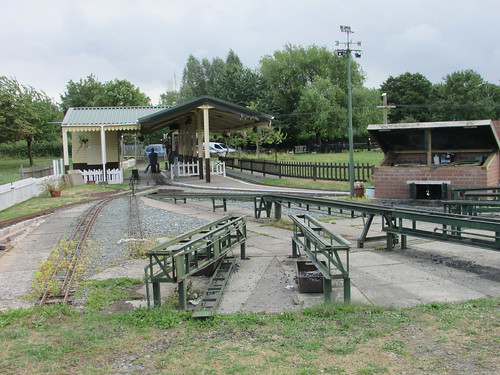
'Lionsmeet' 2018 28th July 2018: Broomy Hill Junction station with the 'HMES Shed' in the foreground featuring turntable, sidings and incline leading to a sector table with six elevated preparation roads radiating. Note the storage bunker on the right with hinging lid.
There is some complex dual-gauge pointwork in evidence, featuring 'back-drive' as now used on modern full-size railways. At least one turnout had multiple 'back-drive' and 'moving frog' construction, eliminating the problem of lack of support to wheels when passing through a 'common crossing'.
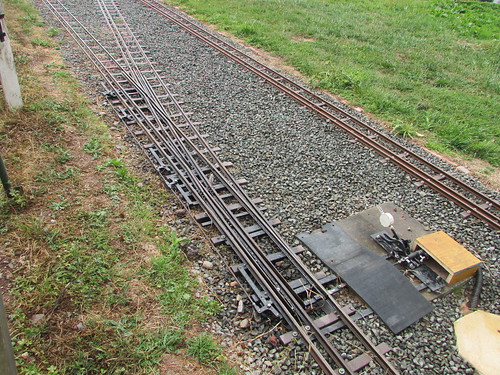
'Lionsmeet' 2018 28th July 2018: Dual-gauge turnout on HMES track featuring power operation, multiple 'back drive' and 'moving frog' design.
I noted that platform 1 through Broomy Hill Junction unusually featured 4-rail dual gauge track, rather than the 3-rail (shared rail, 5 inch rail, 7.25 inch rail) provided elsewhere. Studying my pictures later, the most likely explanation appeared to be that the line had originally been 'out and back' rather than 'continuous'. My pictures show a chord, now removed, which would have allowed out-and-back running.

HMES Broomy Hill: A substantially-built dual-gauge diamond crossing at Broomy Hill Junction.
The ground level track is equipped with realistic, working Western Region pattern lower-quadrant semaphore signals, pneumatically operated from the miniature lever frame in the signal box at Broomy Hill Junction.
John Dalton from Chelmsford Society of Model Engineers steamed his splendid 7.25 inch gauge 'Lion' and later he was joined by resident 'modern image' model in 'Santa Fe' livery with petrol-hydraulic transmission.

'Lionsmeet' 2018 28th July 2018: John Dalton of Chelmsford club attended with his 7.25-in gauge Lion, shown being admired by Harrye Frowen.
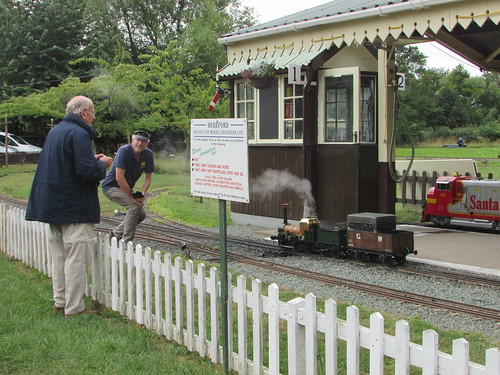
'Lionsmeet' 2018 28th July 2018: Adrian Banks chats to John Dalton about John's 7.25 inch 'Lion'. Note the signal box with working miniature lever frame and resident 'modern image' model on the right in 'Santa Fe' livery with petrol-hydraulic transmission.
Club house
As the weather deteriorated, I made my way towards the club house complex, where an excellent range of 'lunch plates' were available and animated discussions took place. A number of members were displaying models, part assembled models or components for models.

'Lionsmeet' 2018 28th July 2018: Animated discussions in the clubhouse over lunch.
Jon Swindlehust exhibited his 5 inch gauge 'Rocket' commenting that he has run it on air but not steamed it.
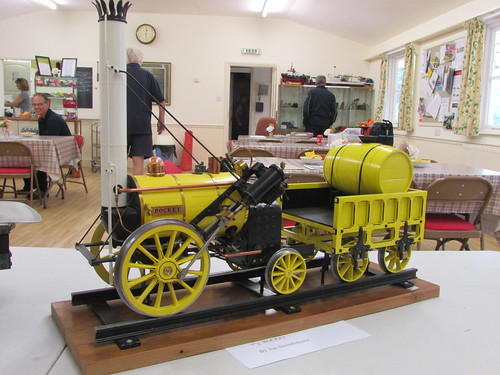
'Lionsmeet' 2018 28th July 2018: 5 inch gauge 'Rocket' by Jon Swindlehust exhibited in the Clubhouse.
Considering the 'fiddly' nature of many of the parts, Jon added that he now wishes it had been a 7.25 inch gauge model! Having worked on the full-size replica (at the Birmingham Railway Museum Gala in 1988, at the Riot of Steam in 2005 and at L & M 180th Celebrations in 2010), I was impressed by the attention to detail. The fidelity to the full-size replica operated by National Railway Museum can be judged by comparison with my picture below.

The National Railway Museum 'Rocket' replica.
But there was a model of an even older prototype on show. Harrye Frowen displayed his remarkable 7.25 inch gauge model of 'Puffing Billy' at an advanced stage of construction.
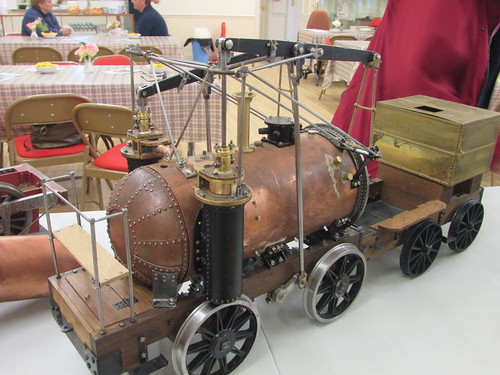
7.25 inch gauge 'Puffing Billy', under construction by Harrye Frowen.

Detail of the geared 4-wheel drive on 7.25 inch gauge 'Puffing Billy', under construction by Harrye Frowen.
The 2018 'Lionsmeet' was the first since the death of much-missed founder member David Neish. His son, Andrew, displayed the familiar 'Lion' model built by David as a static exhibit since the boiler was awaiting a minor repair. That struck me as somehow appropriate.

5 inch gauge 'Lion' built by the late David Neish, exhibited by Andrew Neish.
Following the death of prolific modeller Barrie Larke, his son David exhibited a variety of interesting models.
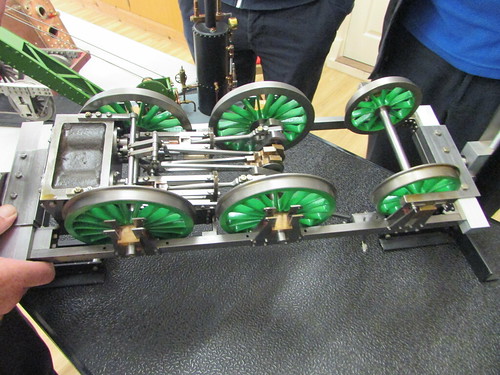
'Lionsmeet' 2018 28th July 2018: Part-built 'Lion' model by the late Barrie Larke.
The HMES Chairman Wally Sykes, a keen modeller and technical writer, gave a brief address to which OLCO Chairman John Brandrick responded, thanking the club for their hospitality.
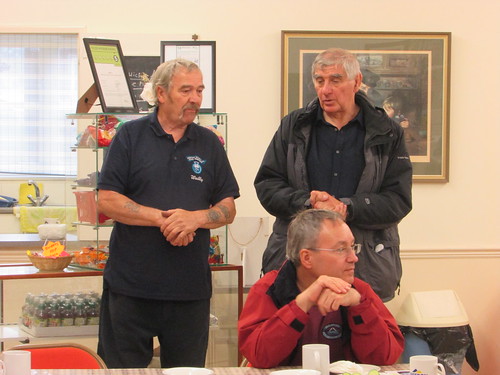
OLCO Chairman John Brandrick (right) responds to HMES Chairman Wally Sykes' address with 'Lionsmeet' Co-ordinator Andrew Neish in the foreground.
I'd been invited to explore the remaining facilities associated with the club house. Next to the clubroom, I found the Project Area with a number of projects in hand. The club has a policy of training young people in engineering, issuing its own certificates as skills are acquired to assist them in seeking employment (there's more information on the Society's website here. I spotted a '14XX' tank engine, complete with part-built auto-trailer and what I assumed was a 7.25 inch narrow-gauge locomotive under construction. One side of the project area houses a 4mm scale model railway 27 feet by 9 feet with accurately-detailed scenery only partly complete. It is based on Ledbury station, with a series of storage loops and a magnificent model of Ledbury Viaduct dominating the scene. The 31 arches of the prototype have been slightly condensed to 28. I'd travelled through Ledbury and over the prototype of the viaduct that morning, as described here. Spectators are separated from the layout by a glazed wall, made to look like the outside of a Great Western coach, complete with brass door handles!

'Lionsmeet' 2018 28th July 2018: 'Ledbury Viaduct' in 4mm scale.
Outside (the rain had abated somewhat) I found two railway van bodies well-equipped as what I assumed were the original workshops. Beyond these workshops was a large garden railway. The main station (provided with both turntable and sector table) was on raised baseboards and provided with a large overall roof. Beyond the station area, the railway was on a mixture of raised baseboards and low-level formation with scenic features.

'Lionsmeet' 2018 28th July 2018: The garden railway.
The club house complex on the hill overlooks the ground level running track on the plain. The substantial carriage shed serving the ground level track has been built on two levels. The upper level, with easy access from the club house level, has its own well-equipped workshop. A ladder and an external ramp lead down to the storage tracks. A model of a GWR diesel railcar particularly caught my eye, based on one of the later batch with the rather angular body styling. When I was growing up, I remember travelling between Wolverhampton Low Level and Dudley on these railcars.

HMES Broomy Hill: Carriage shed storage tracks.
Outside the carriage shed, the four storage tracks combine into one, with the points controlled from a 3-lever ground frame. This track, flanked by the continuous ground level running track which joins from the right, passes through a double-track tunnel (which has a 'secret storage siding') before converging with the continuous track through a small station called Howards Halt, provided with steps to the higher level and the adjacent club house.
The HMES chairman had told me that the whole plains area on which the running tracks are constructed are subject to occasional flooding and up to 3 feet of water has been recorded. So I was prepared for the novel feature of a depth gauge mounted on the tunnel portal!

HMES Broomy Hill: The tunnel portal, with depth gauge mounted on the right side, viewed from Howards Halt. The carriage shed is just visible in the background. Note the 3 storage sidings on the left.
Well, the weather could have been better but the welcome we received from the host club could not have been warmer. After an enjoyable visit, I left Broomy Hill for my train journey home very impressed with what the Hereford Society has achieved on the site.
Related posts on this website
All my posts about the Old Locomotive Committee can be found here, with links to my pictures.
My pictures
Where necessary, clicking on an image above will display an 'uncropped' view or, alternately, pictures from may be selected, viewed or downloaded, in various sizes, from the albums listed:-
Lionsmeet 2018.
All my 'OLCO' albums.
